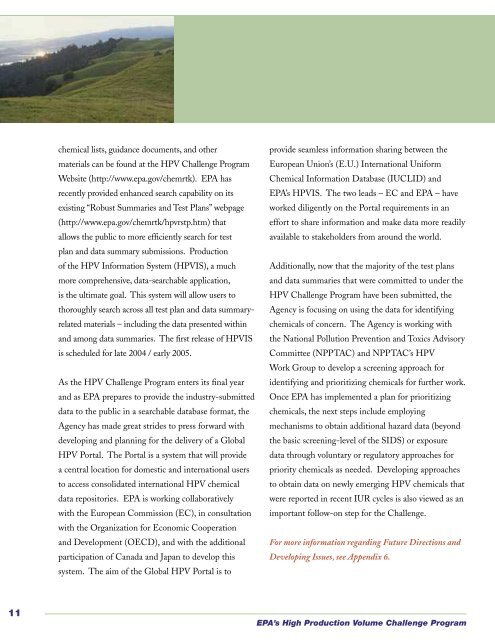Status and Future Directions of the - US Environmental Protection ...
Status and Future Directions of the - US Environmental Protection ...
Status and Future Directions of the - US Environmental Protection ...
You also want an ePaper? Increase the reach of your titles
YUMPU automatically turns print PDFs into web optimized ePapers that Google loves.
11<br />
chemical lists, guidance documents, <strong>and</strong> o<strong>the</strong>r<br />
materials can be found at <strong>the</strong> HPV Challenge Program<br />
Website (http://www.epa.gov/chemrtk). EPA has<br />
recently provided enhanced search capability on its<br />
existing “Robust Summaries <strong>and</strong> Test Plans” webpage<br />
(http://www.epa.gov/chemrtk/hpvrstp.htm) that<br />
allows <strong>the</strong> public to more efficiently search for test<br />
plan <strong>and</strong> data summary submissions. Production<br />
<strong>of</strong> <strong>the</strong> HPV Information System (HPVIS), a much<br />
more comprehensive, data-searchable application,<br />
is <strong>the</strong> ultimate goal. This system will allow users to<br />
thoroughly search across all test plan <strong>and</strong> data summary-<br />
related materials – including <strong>the</strong> data presented within<br />
<strong>and</strong> among data summaries. The first release <strong>of</strong> HPVIS<br />
is scheduled for late 2004 / early 2005.<br />
As <strong>the</strong> HPV Challenge Program enters its final year<br />
<strong>and</strong> as EPA prepares to provide <strong>the</strong> industry-submitted<br />
data to <strong>the</strong> public in a searchable database format, <strong>the</strong><br />
Agency has made great strides to press forward with<br />
developing <strong>and</strong> planning for <strong>the</strong> delivery <strong>of</strong> a Global<br />
HPV Portal. The Portal is a system that will provide<br />
a central location for domestic <strong>and</strong> international users<br />
to access consolidated international HPV chemical<br />
data repositories. EPA is working collaboratively<br />
with <strong>the</strong> European Commission (EC), in consultation<br />
with <strong>the</strong> Organization for Economic Cooperation<br />
<strong>and</strong> Development (OECD), <strong>and</strong> with <strong>the</strong> additional<br />
participation <strong>of</strong> Canada <strong>and</strong> Japan to develop this<br />
system. The aim <strong>of</strong> <strong>the</strong> Global HPV Portal is to<br />
provide seamless information sharing between <strong>the</strong><br />
European Union’s (E.U.) International Uniform<br />
Chemical Information Database (IUCLID) <strong>and</strong><br />
EPA’s HPVIS. The two leads – EC <strong>and</strong> EPA – have<br />
worked diligently on <strong>the</strong> Portal requirements in an<br />
effort to share information <strong>and</strong> make data more readily<br />
available to stakeholders from around <strong>the</strong> world.<br />
Additionally, now that <strong>the</strong> majority <strong>of</strong> <strong>the</strong> test plans<br />
<strong>and</strong> data summaries that were committed to under <strong>the</strong><br />
HPV Challenge Program have been submitted, <strong>the</strong><br />
Agency is focusing on using <strong>the</strong> data for identifying<br />
chemicals <strong>of</strong> concern. The Agency is working with<br />
<strong>the</strong> National Pollution Prevention <strong>and</strong> Toxics Advisory<br />
Committee (NPPTAC) <strong>and</strong> NPPTAC’s HPV<br />
Work Group to develop a screening approach for<br />
identifying <strong>and</strong> prioritizing chemicals for fur<strong>the</strong>r work.<br />
Once EPA has implemented a plan for prioritizing<br />
chemicals, <strong>the</strong> next steps include employing<br />
mechanisms to obtain additional hazard data (beyond<br />
<strong>the</strong> basic screening-level <strong>of</strong> <strong>the</strong> SIDS) or exposure<br />
data through voluntary or regulatory approaches for<br />
priority chemicals as needed. Developing approaches<br />
to obtain data on newly emerging HPV chemicals that<br />
were reported in recent IUR cycles is also viewed as an<br />
important follow-on step for <strong>the</strong> Challenge.<br />
For more information regarding <strong>Future</strong> <strong>Directions</strong> <strong>and</strong><br />
Developing Issues, see Appendix 6.<br />
EPA’s High Production Volume Challenge Program<br />
HPV Challenge Program Conclusions<br />
In conclusion, EPA is very pleased with <strong>the</strong><br />
overwhelming response from companies <strong>and</strong> consortia<br />
to <strong>the</strong> HPV Challenge Program. The extraordinary<br />
response to <strong>the</strong> Program has resulted in a tremendous<br />
amount <strong>of</strong> sponsor-submitted test plan / summary<br />
data being made publicly available. More than 400<br />
companies <strong>and</strong> 100 consortia have sponsored over<br />
2200 chemicals in <strong>the</strong> Program. In addition to <strong>the</strong><br />
851 chemicals sponsored indirectly through <strong>the</strong> ICCA<br />
HPV Initiative, 353 test plans have been submitted for<br />
1,266 (92%) <strong>of</strong> <strong>the</strong> 1,371 chemicals sponsored directly<br />
in <strong>the</strong> HPV Challenge Program.<br />
The majority <strong>of</strong> <strong>the</strong> test information that addresses<br />
<strong>the</strong> SIDS endpoints was comprised <strong>of</strong> unpublished,<br />
existing data, which because <strong>of</strong> <strong>the</strong> HPV Challenge<br />
Program has now been made publicly available. In<br />
addition, category approaches <strong>and</strong> SAR techniques<br />
have been applied to extend <strong>the</strong> available data to<br />
o<strong>the</strong>r related chemicals, <strong>the</strong>reby reducing <strong>the</strong> need for<br />
new testing. The Agency has developed a strategy to<br />
address those from <strong>the</strong> original list <strong>of</strong> approximately<br />
2800 chemicals that have ei<strong>the</strong>r not been sponsored<br />
or have been sponsored but submission <strong>of</strong> test plans /<br />
data summaries are currently overdue. This strategy,<br />
plus efforts to develop <strong>the</strong> HPVIS while working with<br />
o<strong>the</strong>r governments in developing <strong>the</strong> Global HPV<br />
<strong>Status</strong> <strong>and</strong> <strong>Future</strong> <strong>Directions</strong><br />
Portal, will help ensure that more data are accessible in<br />
<strong>the</strong> U.S. <strong>and</strong> internationally.<br />
The Agency is working with <strong>the</strong> National Pollution<br />
Prevention <strong>and</strong> Toxics Advisory Committee<br />
(NPPTAC) <strong>and</strong> NPPTAC’s HPV Work Group to<br />
develop a screening approach for identifying <strong>and</strong><br />
prioritizing chemicals for fur<strong>the</strong>r work. In addition<br />
to chemicals identified from <strong>the</strong> 1990 IUR, EPA is<br />
in <strong>the</strong> process <strong>of</strong> considering options for addressing<br />
HPV chemicals that were reported in <strong>the</strong> most recent<br />
IUR reporting. EPA’s Office <strong>of</strong> Pollution Prevention<br />
<strong>and</strong> Toxics will continue to inform <strong>the</strong> public about<br />
<strong>the</strong> HPV Challenge Program <strong>and</strong> <strong>the</strong> potential uses<br />
<strong>of</strong> <strong>the</strong> collected data. Continued cooperation by<br />
sponsors <strong>and</strong> o<strong>the</strong>r participating stakeholders in <strong>the</strong><br />
Program will ultimately result in public accessibility<br />
to a large amount <strong>of</strong> useful HPV chemical data that<br />
were largely not available to <strong>the</strong> public at <strong>the</strong> Program’s<br />
start in 1998. EPA recognizes <strong>the</strong> contributions by<br />
industry <strong>and</strong> o<strong>the</strong>r stakeholders in <strong>the</strong> HPV Challenge<br />
Program’s accomplishments.<br />
12

















